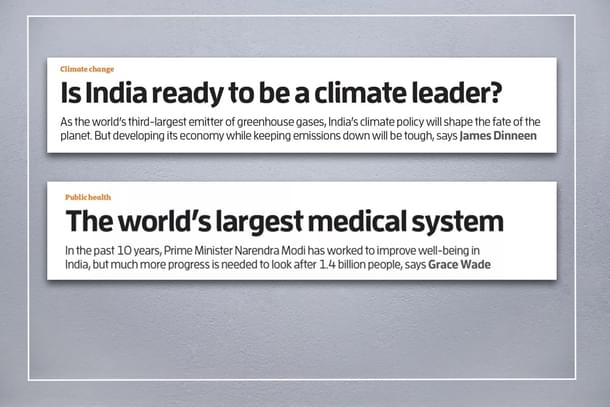World
'New Scientist' Report On Indian Science In The Context Of Elections: Why It Is Important
Aravindan Neelakandan
May 13, 2024, 02:38 PM | Updated Aug 06, 2024, 12:40 PM IST
Save & read from anywhere!
Bookmark stories for easy access on any device or the Swarajya app.


In its 4 May 2024 issue, the reputed British science magazine ‘New Scientist’ has focussed on the dimensions of science in the context of India’s elections. The special news focus has four reports and a minor one on deepfakes.
The first one is on climate change and India’s policies in the context of international efforts to combat global warming. The report shows the true picture of the efforts that the Modi Government has been taking with all the challenges it faces:
India is now the world's largest annual emitter of greenhouse gas after China and the US, having overtaken the European Union just last year. Under Modi's government, India has also taken steps to rein in these rising emissions while simultaneously addressing widespread energy poverty.... Renewable energy is booming on the subcontinent. There is growing adoption of electric vehicles-especially two-wheelers - and there are ambitious plans for it to become a green hydrogen powerhouse.
The report also points out that Modi's administration became ‘the first Indian government to set specific national climate targets’ among which the main one is for India ‘to reach net-zero emissions by 2070.’
This realistic and justifiable target is a point of meeting between the historic low emissions of India, its low per capita energy consumption and projected tremendous increase in energy demands. For a balance between coal and renewable energy to limit emissions, Modi Government made a target of 175 gigawatts in 2022 and 500 gigawatts by 2030. The report notes:
India missed the 2022 target, but it has built a record amount of renewable capacity since then... Solar in particular has boomed. Between March 2023 and March 2034, about 15 gigawatts of solar capacity came online — a record amount. However, 50 gigawatts of additions will be needed each year to reach the 2030 renewable target.
The report also notes that given almost all solar panels are China imports, the tariff increase because of the border tensions making them expensive, India has sought to establish domestic solar panel production with mixed success.
The report on India's medical system points out that 'in the past 10 years, Prime Minister Narendra Modi has worked to improve well-being in India' even as 'much more progress is needed to look after 1.4 billion people.' The report points out that while many developing countries use about 6 per cent of its GDP for healthcare, India spends less than 3 per cent of its GDP on healthcare.

While healthcare is not much of an election issue, the report points out that Modi's 'Swachh Bharat' Mission increased the population with access to a toilet increased from 39 per cent in 2014 to 95 per cent in 2019.
Another aspect highlighted by the report is the phenomenal addition of 50,000 kilometres of highway over the past nine years which in turn has improved accessibility to clinics and hospitals. This in turn has had positive effects in equally phenomenal drop in maternal mortality.
Apart from these, there are also specific healthcare schemes launched by Modi — 'Pradhan Mantri Jan Arogya Yojana' (PM-JAY). It is the largest public health insurance scheme in the world with 40 per cent of India's population qualifying for it. There are also problems like quality of care etc. and the unsubstantiated claims made by some practitioners of the traditional medical systems, even as PM promotes India's traditional medical knowledge on a global scale, the article claims.
The third report explores the possibility of 'building a powerful computer chip industry.'
It starts with Narendra Modi setting a target for India to become one of the world's five biggest computer chip manufacturers by 2029. Then the report looks into the opportunities and challenges.
While 'the rise of artificial intelligence and unstable geopolitics' does create 'a global scramble to build chip factories' India's competence matters here, points out the report. India can attract foreign investment and a share of existing chip manufacturing' and already Apple is considering moving a quarter of iPhone production from China to India next year.
But true silicon independence, the report says quoting an expert Rakesh Kumar at the University of Illinois, 'will require an infrastructure of supporting suppliers and skilled workers, along with large and continuing investment.'
Kumar also points out that India strategically does not compete with the cutting edge of the industry but boosts the production of 28-nanometre chips used in cars and household appliances with production techniques of the early 2000s. In fact, this is how China also started.

The next report is on space science.
Predictably the report starts with ISRO’s achievement of soft moon landing at the southern lunar pole. It points out the leapfrogging strategy of the visionary founder of the Indian Space Research Organisation (ISRO), Vikram Sarabhai.
Itty Abraham, a professor in the Arizona State University School for the Future of Innovation in Society (SFIS) points out that this strategy of ‘absorbing technologies from different countries and stitching them together to make something uniquely Indian.’ Prof. George is quoted crediting Narendra Modi for bringing in private players in India’s space mission:
Where Modi has made a difference is that he has encouraged the private sector to step in in a way that is very unusal for Indian government programmes.
Now ISRO has set a path with such a prestige that its progress in that direction is irreversible.
All four major reports on India in the context of India’s general elections should be seen from an important perspective. Usually, when there is an independent assertive leader arising in post-colonial countries, who does not fit the expectations of the West, the Western press starts churning out negativity about that leader. Usually such leaders, to the delight of the West, would also be dictators.
But Narendra Modi has defied these unwritten ground rules of the West. He is assertive. He is openly rooted in Hindu civilization which for the Western deep state is a major irritant. He is also making the nation progress in science and technology.
Yet the Western press from 'The Guardian' to 'New York Times’ has tried to defame and demonise Modi. Unfortunately ‘Nature’ also joined the bandwagon with lesser rhetoric by publishing an op-ed by an anti-Modi columnist pretending to worry about science in India.
Indians are seeing how supple and domesticated the journalism of the so-called ‘free world’ is, when they report for the wishes of their deep state. This has eroded the reliability of Western journalism in India.
So ‘New Scientist’ report on science in India, should be seen positively not as a Western endorsement of science in India. Far from that, it should be seen as an endorsement of the presence of an unbiased space still existing in Western journalism.
As a nation pulsating with vibrant scientific and technological advancements and impressive achievements of late, many Indians mostly share a perception. They perceive Western media coverage of their country’s progress in these fields as negatively biased, and not without reason. This bias, bordering hatred and darkly morphing into contempt, seems to intensify when the narrative involves Narendra Modi.
Such weaponising of journalism for transnational political changes is dangerous to the freedom and autonomy of journalism and will erode the credibility of media which is already at a low ebb.
However, Western journalism still seems to have space to redeem itself. ‘New Scientist’ has presented a more authentic picture of India’s scientific and technological landscape, particularly in the context of the 2024 general elections.
This refreshing perspective demonstrates that Western journalism can indeed rise above its conscious or unconscious colonial hangovers, particularly when reporting on the strides made by a post-colonial nation that is assertively embracing its civilizational roots.
This also shows that science journalism, when not misused for ideological vested interests, can help humanity come together without envy and biases, to celebrate the scientific and technological triumphs of a resurgent nation, as part of the one global family or as Hindus say ‘Vasudhaiva Kutumbakam.’





